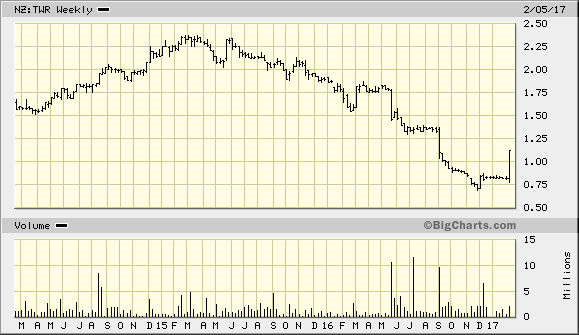Prem Watsa of Fairfax Financial Holdings (aka Canada’s ‘Warren Buffett’) has announced it will make its first acquisition down-under with a NZ$197m offer for New Zealand based Tower Limited.
Let’s take a look at the deal in more detail to see why this stacks up as a good acquisition for Fairfax.
1) Earthquake provisions driven Towers stock down…
The market has clearly mispriced Tower’s stock in recent times as seen by the 65% reduction in its share price over the last two years. But why?

There have been two changes that have driven the stock price over the last few years.
- The first being the divestments of Tower’s Life, Health and Investment businesses resulting in what has been a pure P&C insurance play over the last couple of years – a good outcome driving the rally to ~$2.25/share
- Reported net losses in the last two years (FY15 $6.6m, FY16 $21.5m) resulting in the stock falling towards ~$80c/share prior to the deal being announced.
The P&L below highlights these recent losses, which are largely driven by below the line items. Despite these being “one-offs” the market has largely ignored the underlying profit which was most recently $20.1m in FY16. At face value, the $197m acquisition price implies a trailing underlying PE of 9.8x – not a bad starting point for a favourable deal.

However, the markets reaction to these results suggests it does not believe these one-offs are indeed one-offs as can be seen by the $36.2m impact in FY15 and $25.3m impact in FY16 – these were are result of increased claims provisions related to the Feb-11 Canterbury earthquake. The run-off of these liabilities has been complex, but Tower’s net provisions currently stand at only $41m with 89% of claims by number having been settled and 96% by value. To make matters worse, there are disputes related to reinsurance recoveries from the Earthquake Commission (EQC) of $58m and one its reinsurers for $44m which provided adverse development cover.
2) The volatility of past business masks the profitability of new business…
The markets frustration with Earthquake related costs being volatile on the P&L is understandable. However, the share price reaction has been too harsh providing the window of opportunity for Fairfax to acquire it cheaply. Managements answer to unlocking value was to split the business into two “New Tower” and “RunOffCo” – effectively separating the good business from the bad business. This would have likely worked, but Fairfax has jumped in before implementation.
3) Tower has quality float, made cheap by the markets frustration with EQ losses
With Fairfax being a “mini-Berkshire” we can look at this insurance acquisition under the lens which Buffett also looks at them – cheap quality float. What we see is that despite paying $1.17/share or a 47% premium to market, the acquisition is in fact very cheap.
- Underwriting profitably – Tower has average NEP of ~$250m with average underwriting margins of 9% meaning there is no cost to the float – indeed it is throwing off very healthy profits. With claims ratios of ~50% and management targeting expense ratio of <35% in the future, is it feasable that the business could deliver an 85% COR (or 15% underwriting margin).
- Acquiring Float – Tower’s FY16 accounts showed $1.66/share of cash and investments. Compared to the $1.17/share price offered, this suggests Prem Watsa is acquiring float for 70c in the $.
Another way to look at it is if Prem achieves a 5% after tax return on the investment book and underwriting can achieve an 85% COR, that would equate to around 23c of EPS, putting the deal on a 5x PE. Not bad…
However, the issue is obviously around the earthquake provisions which Fairfax is also acquiring. What if these blow up? Given these liabilities are 90-95%+ developed, a major blowout is probably unlikely. While the $41m of claims reserves should account for any future payments, further volatility (both positive and negative) is possible as the business runs -off and capital is released.
If we hypothetically assume that the FY16 reserve deterioration of $25m is ongoing and continues to repeat (a bear case), then these losses can largely be offset through $25-30m of underlying profitability of current business. It would appear in a bear case, the good business can fund losses in the bad business and in the meantime Prem still gets to keep the float that he acquired at 70c per dollar. Not a bad downside scenario – and significant likely upside should the run-off business behave!
In an ideal scenario Prem has paid $197m in exchange for $280m of Investments and $25-30m of annual profit! This is a great deal by any measure. It does make me wonder why Tower’s board has unanimously supported the deal and isn’t shopping around for a better offer, and why major shareholders representing 18% of the shares have voted in favour of the deal.